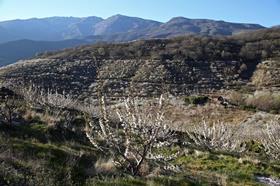
Nearly two million cherry trees have blossomed in Spain’s Jerte valley ready for the start of the Picota season in June.
The blossom is one of the main tourist attractions in the valley, which is located 200km west of Madrid, in northern Extremadura.
The trees are grown on the slopes of the mountain, on terraces. To flower, they need to accumulate between 800 and 1,000 cold hours during the winter, supporting temperatures between zero and six degrees centigrade. They must wait for the frosts to finish to reveal their flowers.
Miguel ángel Durán, export manager at Agrupación de Cooperativas Valle del Jerte said: “The blossom has already reached the upper part of the valley. This year, if the weather continues as it is, we expect a very good cherry season.
“We anticipate large volumes and good quality as the trees have had enough cold hours to offer us their best fruit.”
When the cherries are ready to be harvested at optimum ripeness, they are hand picked, leaving the stalks behind, and placed into chestnut baskets.
This method has been handed down from generation to generation. The cherries are then sorted one by one, at the base of the trees, as the farmers select only the best ones to be sold and eaten. The Picota cherries are then packaged in the Jerte Valley and shipped off to their final destinations.
Picota cherries are unique to the Jerte Valley, and are protected by a denomination of origin (PDO) certificate. This verifies the fruit has been grown, harvested and packed under rigorous quality control procedures.
The exclusive product is distinguished by its flavour and sweetness. They are the only variety that are detached from the tree without a stalk and have a fleshier, crunchy texture than other cherries.
The variety is available in UK supermarkets from the end of June to the beginning of August.



